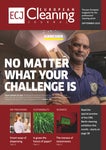Home › blog › 2025 › September › 1st › we are like a wave
We are like a wave
1st of September 2025 Article by Wioleta TomaszewskaWioleta Tomaszewska is a BU support planner in cleaning at Coor FM (one of the leading service providers in the Nordics) and lecturer in cleaning management. She previously worked as an area manager in the cleaning department of Bergen Municipality, Norway.
Here she talks about how the 'wave effect' has influenced her leadership journey in the professional cleaning sector.
About 10 years ago, I worked as a team leader in a cleaning company. Every summer, over the course of three weeks, I was responsible for deep cleaning more than 20 kindergartens. But how could I ensure quality without becoming "blind" after checking hundreds of rooms in a row?
Competence and learning play a central role in every profession. Like many other industries, the cleaning sector is constantly evolving, and upskilling should be part of every company's strategy. Competence includes knowledge, skills, abilities and attitudes. But not all employees benefit equally from a shared competence strategy. Our industry consists of people with different educational backgrounds and attitudes toward work. How can we involve employees at all levels and uncover informal competence?
Rapid changes in society open up new arenas for learning - one of them is social media. Companies have different policies when it comes to social media use. Some use platforms like Facebook, Instagram or Teams groups to engage and develop their staff. Social media enables better information flow and knowledge exchange, supporting continuous improvement. Together with collaboration, communication and the elimination of non-value-adding activities, this reflects the core principles of the Lean concept, which has become increasingly influential in modern operational management.
So how did I ensure the quality of cleaning across 20 kindergartens? The truth is, I didn't. It simply wasn't physically possible to maintain full concentration through every inspection. But the cleaners who did the work managed it, including many temps with little experience, hired just to earn some extra money over the summer. How was that possible?
Thanks to the wave effect. Each cleaner was responsible for deep cleaning one room at a time and for ensuring the quality of that room. They could not proceed to the next room until the colleague cleaning the neighboring room had done a joint check with them. The check was always done together and the person requesting the check had to correct any issues found.
Once the room was cleaned and checked, the cleaner moved to the next available room. The team progressed through the building like a wave-from one side to the other. No rooms were forgotten, and the cleaners learned from one another. From room to room, their competence grew.
Over time, I've come to understand the importance of a healthy work environment, both physical and psychosocial. Focusing continuously on the work environment increases motivation and is crucial for reducing sick leave and improving productivity and quality. Social media can be a great help in this effort. All of my employees have been members of an internal group focused specifically on work environment, for example.
Through weekly Teams meetings we developed strategies and campaigns, and explored how to involve all staff in improving the workplace environment. The group turned out to be an arena for uncovering hidden knowledge. Some were talented influencers, others skilled with cleaning machines while others kept the comment section lively.
A team is only as strong as its weakest link. The insight created by the working group helped us uncover competence gaps at both the individual and team levels. These insights inspire campaigns like #glovecampaign or #ergonomiccampaign.
Our focus on continuous improvement also highlighted the value of the incident and improvement reporting system. One of the goals of the group was to normalise reporting deviations and submitting improvement suggestions. This led to an increase in reports.
Cleaners at different levels regularly received new tips, work methods and routines. Messages were primarily conveyed visually through pictures and short videos. To reinforce learning, cleaners sometimes worked together across locations. This gave them insight into each other's work and allowed them to reflect on different approaches. Their discoveries were shared in the social media group, so everyone could learn from the process.
Customers played a crucial role in both the physical and psychosocial work environment, especially when cleaning services were provided during the daytime. They helped us eliminate everyday inefficiencies like high doorsteps or challenges with waste sorting. Results were shared in our social media group. Cleaners discussed problems with colleagues, influenced others and were themselves influenced. This built empowerment and a sense of safety.
That's what the wave effect means to me today, and in my previous role my team was successful in getting involved an intranet that was also a valuable platform for promoting the cleaning profession internally among building users. There, we shared positive stories from everyday life, where cleaners played a central role.
Today, I can say that the wave concept I developed in my first job laid the foundation for my leadership journey. The wave effect enables independence, collaboration, and competence development and is a key part of continuous improvement. This mindset stays with me. Being like a wave, and learning from one another, is the key to reaching our shared goals.







